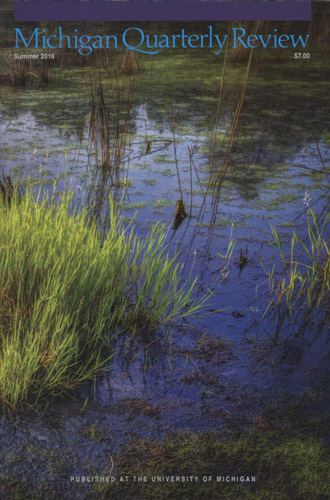Michigan Quarterly Review – Summer 2016
No one who regularly reads university journals is going to be surprised that the Michigan Quarterly Review contains quality short work from some of the best authors. The Summer 2016, issue is certainly no disappointment. Twelve authors have provided us with the level of work we have come to expect and respect. It is always difficult to select one author’s work over another, especially in a respected collection, so your pardon if I don’t mention everyone.
No one who regularly reads university journals is going to be surprised that the Michigan Quarterly Review contains quality short work from some of the best authors. The Summer 2016, issue is certainly no disappointment. Twelve authors have provided us with the level of work we have come to expect and respect. It is always difficult to select one author’s work over another, especially in a respected collection, so your pardon if I don’t mention everyone.
Fittingly enough, the journal opens with Susan Choi’s Hopwood Lecture at the University of Michigan in April 2016. It is a personal piece that not only speaks to writers:
If the writing of novels is going to be compared with a mental process both involuntary and unconscious, certain practical questions arise. The first is, how do you know you’re not writing a novel?
but also speaks to lovers of life and literature: “I reaffirmed then the truth that literature is the organizing of experiences, the ordering of emotions.”
Next, I was struck by the charm of Natalia Romero’s poetry; not the least diluted in translation, it is delightful in both Spanish and English. La Comadreja and Lobito bring us images of natural life interposing our casual and otherwise unimaginative travels.
El lobo blanco
Se hundió en el agua
De color púrpura con la tarde.
Una alegría sin sonido
Más que el desprenderse
De algunas matas del arroyo.
No volverá.
The white otter
dove into water
purple with afternoon.
A joy soundless
save the tearing
of a few weeds from the stream.
He won’t be back.
Just as moving, in “Glencliff,” Cynthia Dockrell sends a series of sequentially revealing letters from a young girl confined to a tuberculosis sanitarium for her cure. Quickly we empathize with her relationships and her love for the normal things in life. To her sister:
When I got here that first day and Rita took me up to this little room and put away my clothes and gave me a nightgown and told me to get into bed, it felt like I was being punished for some crime I didn’t commit. It’s not like I tried to get sick.
To her lover:
I still watch for the mailman every day, hoping there’s a letter from you. When you didn’t write and didn’t write, I was so afraid of what that meant, . . . But then I wrote to Ginny and she answered that you’re still there. So maybe you just haven’t had a chance to writer back? I keep hoping I’ll hear from you soon.
The pieces are often capable of becoming ‘reminiscences’ for some of us. Elizabeth Poliner’s “Home Waters” and Barbara Krasner’s “Red” use childhood images and events to tell stories with much deeper heart and meaning. They are both full of detail and sensory appeal (ambiguity intended).
From “Home Waters” we see:
The girl had lain down, there at the next aunt’s doorstep. Cradling her stick and her picture, she repeated as much of the rhymed story as she could. And she continued to repeat it, like a bedtime prayer, until she felt her eyelids grow heavy, just as they did at night. She was all but asleep when the door opened and her aunt, crying Shekindela! Dear child! whisked her up—just like always . . .
From “Red” we see:
I had a dream last night. I saw a Star of David made of metal, iron maybe. There was an opening, a doorway in each point of the star. Through each doorway was a fist—green, yellow, purple, blue, orange, or red. Some were gnarled with long nails and search for something to grab. Others beckoned. Monsters?
And of course there’s more. All the work in this issue draws the reader into life’s experiences; fiction or not, it works the way we want literature to work for us.
[www.michiganquarterlyreview.com]





